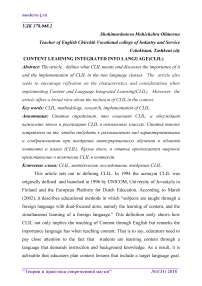Content learning integrated into language(CLIL)
Автор: Shohimardonova M.O.
Журнал: Теория и практика современной науки @modern-j
Рубрика: Основной раздел
Статья в выпуске: 1 (31), 2018 года.
Бесплатный доступ
The article defines what CLIL means and discusses the importance of it and the implementation of CLIL in the non language classes. The article also seeks to encourage reflection on the characteristics and considerations when implementing Content and Language Integrated Learning(CLIL). Moreover the article offers a broad view about the inclusion of CLIL in the context.
Clil, methodology, research, implementation of clil
Короткий адрес: https://sciup.org/140289434
IDR: 140289434
Текст научной статьи Content learning integrated into language(CLIL)
This article sets out to defining CLIL. In 1994 the acronym CLIL was originally defined and launched in 1996 by UNICOM, University of Jyvaskyla in Finland and the European Platform for Dutch Education. According to Marsh (2002), it describes educational methods in which “subjects are taught through a foreign language with dual-focused aims, namely the learning of content, and the simultaneous learning of a foreign language.” This definition early shows how CLIL not only implies the teaching of Content through English but remarks the importance language has when teaching content. That is to say, educators need to pay close attention to the fact that students are learning content through a language that demands instruction and background knowledge. As a result, it is advisable that educators plan content lessons that include a target language goal.
The term CLIL becomes an umbrella term to cover “learning through any language that is not the first language of the learner” (Ball, 2006). CLIL entails teaching the foreign language while students learn subject – matter.
The implementation of CLIL
CLIL works well when it is implemented effectively. For instance, when students learn a subject; namely, history, geography or science through the medium of a foreign language; the foreign language acts as a vehicle for learning, thus educators plan integrating not only content and language but also procedures by stating how content will be addressed in such a way that it is meaningful for every learner, no matter their proficiency level. Being able to communicate academically and socially opens new borders and encourages students to explore and travel around the world. When integrating content and language, students have the opportunity to acquire both Basic Interpersonal Communications Skills (BICS) and Cognitive Academic Language Proficiency (CALPS) with the former being all the social language skills and the later the language skills to cope with academic requirements. When teachers are planning a CLIL lesson, there are five things to think about - Content, Communication, Competences, Community and Cognition.
. Content
In traditional teaching, teachers prepare a lesson around a logical development of the area the students have been working on. It’s just the same with CLIL. Teachers develop lessons around what the students already know. In this way, students build their content knowledge like building a wall, one course of bricks on top of the next.
-
2. Communication
-
3. Competences
-
4. Community
-
5. Cognition
In the past, students learned a lot of lesson content while they were listening to the teacher talk. With CLIL, teachers talk much less, because the students don’t have enough experience of the new language to learn in this way. Instead, students study together and work in groups, talking to each other as well as to the teacher, using as much of the new language as they can.
‘ Can-do’ statements describe the outcomes of a lesson, for example, ‘I can speak about the history of Uzbekistan in English’. CLIL teachers think about the can-do statements they want their students to be able to make after the lesson, either about lesson content and skills – or about new language.
CLIL teachers help students to relate what they learn to the world around them. Students see that what they learn is not just a school subject, but something that relates to ‘the real universe’.
Of course, teachers always help students to learn to think long before the CLIL approach is introduced. They always ask their students ‘when?’, ‘where?’, ‘which?’, ‘how many?’ and ‘who?’. These questions focus on real, specific and concrete answers. Students who learn to answer them correctly develop the thinking skills of recalling, repeating and listing, and of course understanding. In summary, when using CLIL, both language and content are simultaneously given attention and they are both essential in thelearning process. The language is used as a tool to learn the contents of the subject, and those contents are used as a meaningful medium to learn and use the language communicatively. All in all The benefits of CLIL may be seen in terms of cultural awareness, internationalization, language competence, preparation for both study and working life, and increased motivation.
Список литературы Content learning integrated into language(CLIL)
- Уринбоев Х. Б., Мамажонова Г. К. САМОЦЕННОСТЬ И СМЫСЛ ЧЕЛОВЕЧЕСКОЙ ЖИЗНИ //Теория и практика современной науки. - 2017. - №. 3. - С. 741-743


